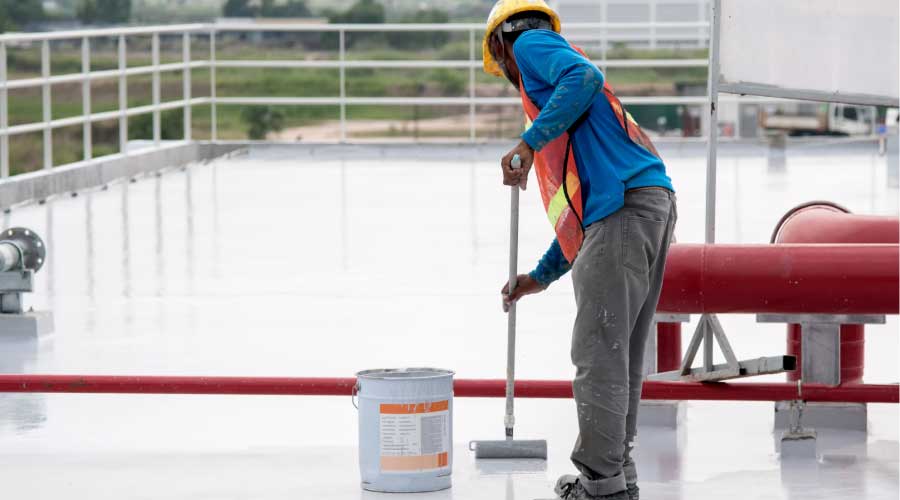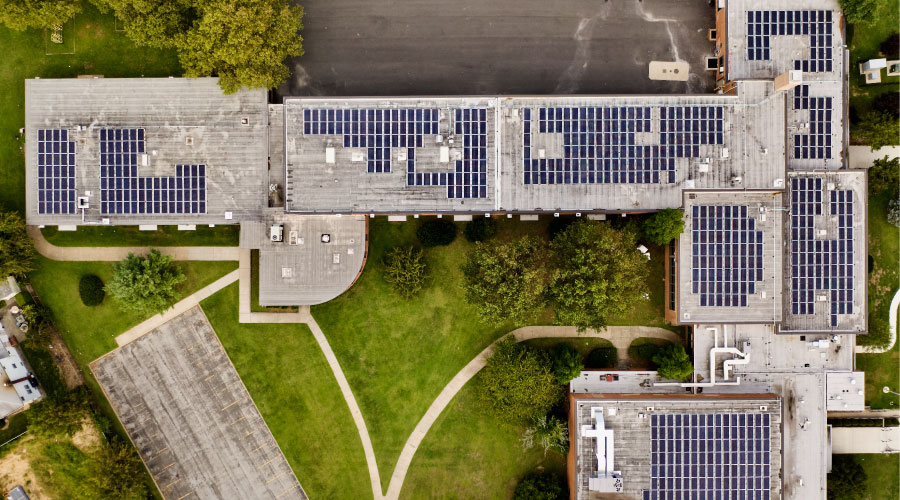Roof Coatings: Specification Strategies
Understanding facility needs and roof coating options can help managers specify products that deliver protection and energy savings
Special Report: Roof Coatings in conjunction with the Roof Coatings Manufacturers Association
With each new year, institutional and commercial facilities ratchet up their efforts to control costs. Rising costs related to labor, products and utilities have inevitably led to heightened scrutiny of all areas of operations. So a product that can protect critical facility assets, as well as help control energy costs, is likely to attract more than a little attention.
Roof coatings might not automatically come up as often as other products when talk turns to energy savings, but a growing number of maintenance managers are investigating the benefits coatings can generate for their organizations. Research and experience can give managers a better understanding of the performance and protection characteristics of roof coatings and help them match coatings on the market to their facilities’ needs for a range of roofing types, locations and climates.
“We have, over many years of trying a number of different products, found material and coatings that work and hold up extremely well in the Las Vegas area,” says Clark Neilson, coordinator of general repairs for the Clark County (Nev.) School District (CCSD), which includes Las Vegas.
High-level Benefits
The primary allure of roof coatings is their ability to protect big-ticket, in-place assets — namely, roofing systems and the essential operations within facilities. Organizations have invested heavily in technology and infrastructure related to their core missions and do not want operations interrupted or materials damaged due to a roof leak that could have been prevented.
For this reason and more, managers need to pay close attention when specifying and applying coatings.
“We have learned from experience how cost-effective coatings can be in extending the life of roofs,” Neilson says. “When you’re dealing with over 750 acres of roofing, it’s important to use products that work the first time because we don't have time to go back and do it again.”
Coatings fall into two general categories — bituminous-based and elastomeric-based products.
Bituminous-based coatings are manufactured to be compatible with either asphalt or coal-tar built-up roofing systems or with modified bitumen membranes. These coatings also are used as a cost-efficient material to prolong the life of metal roofing.
The base materials for elastomeric-based coatings include acrylics, Hypalon, neoprene, silicone, urethane and hybrid materials, and the coatings industry continues to work on developing and testing new products. These coatings are compatible with most types of roofing systems but appear to be used most widely on single-ply, spray-applied polyurethane foam, and metal roofing systems. Elastomerics also can be used on most built-up and modified bitumen systems.
Besides protecting roofs and facilities from moisture, some coatings offer another benefit. Reflective and light-colored coatings can help facilities curtail energy costs and minimize facilities' impact on the environment. By reflecting the sun’s ultraviolet rays to protect the roof and reflecting the visible and infrared sunlight to keep rooftop temperatures from rising, coatings help keep facilities cooler and minimize loads on energy-using HVAC systems.
Manufacturers of reflective coatings, as well as coatings that use lower levels of volatile organic chemicals (VOC), tout the environmental benefits of some roof coatings. These benefits are not lost on some managers, who are aware of the growing interest in environmentally friendly products within their organizations.
For example, students at Southern Methodist University (SMU) in Dallas frequently demand that the university use environmentally friendly products whenever possible, says Robert Casagrande, SMU’s director of plant operations and facilities maintenance. The environmental appeal of some roof coatings has provided him with a response to students’ questions.
“At the university level, perception is everything,” he says. “We derive some hard-cost savings (from roof coatings), but probably more savings come from soft costs. It’s great PR.”
In on the Ground Floor
While some facilities are newcomers to specifying roof coatings, others long ago bought into the benefits of coatings.
“Our roofing department has been involved with has been involved with this product for about 20 years,” CCSD’s Neilson says. “Within the CCSD, every type of roof imaginable has been installed and tested over the last 50 years — metal, Hypalon, built-up, shingles, modified bitumen, concrete and foam,” adding that foam systems are a popular choice.
“But foam by itself isn't enough,” he says. “It requires a highly reflective coating to help the system achieve its maximum capabilities and protect the foam from the damaging rays of the sun.”
Milwaukee Public Schools (MPS), with about 8.5 million square feet of roofing, has developed a strategic roof maintenance program that includes recoating its roofs every five years in an effort to squeeze another 15 years of performance life from its built-up roofs (BUR).
“We specify an aluminum-fibrated coating for reflective properties and wear protection on all of our built-up roofs,” says Richard Moore, the district’s director of the division of facilities and maintenance services. “We typically hope to get 40 years from our BUR systems.”
Doing the Homework
Because facility needs differ widely and coatings options are growing, managers making specification and purchase decisions need to rely on a range of information sources, including manufacturers, contractors, government programs and peers. Because managers put great stock in the experiences of their peers, they might be among the most influential sources.
“We don’t want to be a guinea pig for anything,” says one manager.
Manufacturers remain a trusted source of information on roof coatings, particularly when it comes to application, given that they have the most technical knowledge and insights about their products.
“Knowing the details recommended by the manufacturer and the specifications listed on the material safety data sheets are valuable in our decision-making process,” Neilson says.
For more information on coatings performance, managers also turn to:
Finally, many managers trust their own experience and research on roof coatings. At MPS, Moore’s department conducts its own field tests on roofing systems and roof coatings to better understand which materials work best in Wisconsin’s climate.
Given the central role in protecting facilities and operations, managers often rely on their in-house experts for input on such products as roof coatings.
“Our maintenance department roofing shop consists of a supervisor, two lead men, and 10 journeymen roofers, which equates to 260 years of experience in the field of roofing,” Neilson says. “All of these individuals are well-versed in a variety of different types of roofing systems and are very competent in their knowledge and skills in installing, repairing and maintaining roofs.”
No matter where the information comes from, however, managers are likely to remain interested in the potential benefits of roof coatings. Products that offer protection to roofing systems and facility operations and that can address facilities’ need for energy savings have a way of attracting that kind of attention.
Coatings: Mistakes and Misconceptions
Common mistakes often undermine managers’ best-laid plans when it comes to specifying and applying roof coatings, according to manufacturers.
“The most common mistake is not following the instructions on the label,” says Paul Beemer, director of legal and technical affairs for Henry Co. This is particularly true when it comes to applying the appropriate amount.
“Some think more is better,” says Van Ripps, president of Palmer Asphalt Co. “As a result, users often over apply the products.” Other users believe products can be diluted.
“Users try to increase the coverage of the material by thinning it, which reduces the quality and integrity of the product,” Ripps says.
Another step users often perform improperly is preparing the surface, which is critical to a coating’s performance, says Richard Lee, senior chemist for Tremco Inc. “A coating is only as good as the surface it’s applied to.”
End users also are sometimes overwhelmed when trying to choose a coating that is best suited for a specific roof application, says Nick Hecei, general manager of Uniflex Roofing Systems, a KST Coatings Manufacturing company.
“End users must gain a better understanding of the variety of coatings available and how these coatings will, or will not, benefit their specific application,” Hecei says.
Besides selecting the wrong coating, some managers try to make a coating do something it was not designed to do, Beemer says, adding that coatings must be used only for their intended purposes. Unrealistic expectations of roof coating can lead to disappointment. A roof coating is not the “miracle in a can” as some might believe, Hecei says.
“They wait until their roof has deteriorated beyond the normal coating maintenance cycle and may believe, because a coating application is typically more economical than other systems, that a roof coating is best suited for their application,” he says. “As a result, they expect the coating application to perform beyond realistic expectations and could be disappointed when it doesn’t.”
|
Spotlight: RCMA
The Roof Coatings Manufacturers Association (RCMA) is the national trade association representing manufacturers of cold-applied protective roof coatings and cements, as well as suppliers of products, equipment and services to the industry. Since its founding in 1982, RCMA has grown to be a respected voice in the building-construction industry. The association has tripled its membership to almost 60 member manufacturing and supplier member firms and affiliate and contributory members. Association benefits and activities include:
- a vehicle for input into federal and state regulations and legislation
- government affairs and regulatory issue updates
- technical and regulatory compliance educational seminars
- five active committees, two active councils and specific program task forces
- a new membership option, the white coatings division, to serve producers and suppliers of acrylic or elastomeric coatings.
Contact RCMA at (202) 207-0919, fax (202) 223-9741
|
Related Topics:











